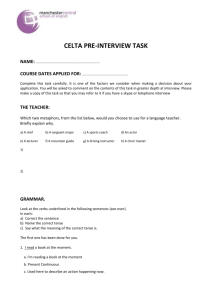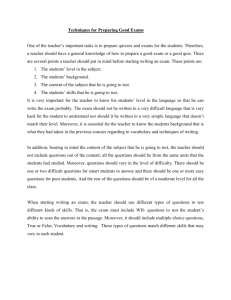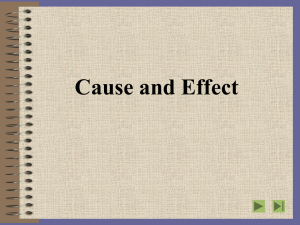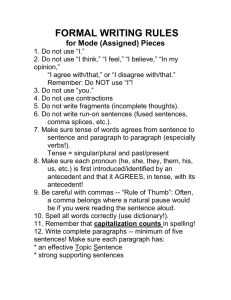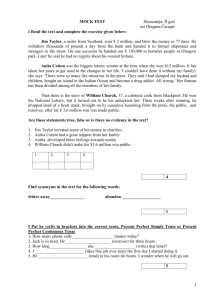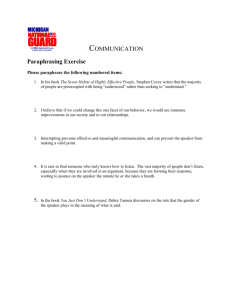News Training Packet
advertisement
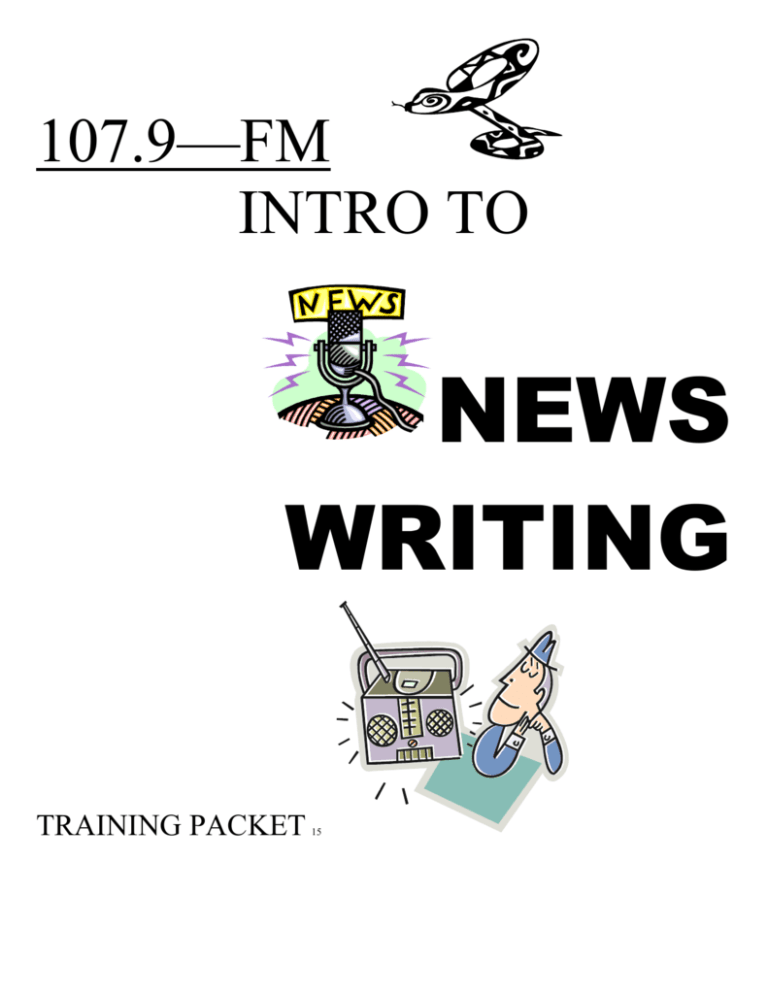
107.9—FM INTRO TO NEWS WRITING TRAINING PACKET 15 Radio News Tips Worksheet--1 07 1. KISS: Keep Words, sentences and stories simple and short. 2. Write the way people talk: Write INFORMALLY and CONVERSATIONALLY. 3. Begin with a lead: a complete sentence that catches attention, includes a fact (but not the most important fact), angles the story and sets the listener up for the rest of the story. 4. Rules for Leads: (These rules are ONLY for leads, the first sentence of news stories): NO OLD NEWS !!!! No past tense !!!! Tell what is going on NOW OR IN THE FUTURE (Past stuff can go in the rest of the story.) NO NAMES of PEOPLE in the lead. (Save them for later in the story.) (Other names are ok.) NO NUMBERS in the lead. (Save numbers for later in the story, and use them sparingly.) NO HEADLINES !!!! Write the way people talk. Write complete sentences. (Make sure you use verbs !!!) Don’t force the present tense by trying to disguise something that already happened as present tense. Avoid what has already happened, and start with what is going on now or in the future. Don’t force present tense if it doesn’t fit. When appropriate, use a different type of verb that is not past tense. HARD LEADS: This is the most common type of lead, and should be used for most stories. These leads catch attention, but include a fact that angles the story. A hard lead gets to the point quickly. SOFT LEADS (Also Known as “Throw-Away” Leads): Use these types of leads on occasion, to add variety to your news stories, for feature or “softer” type stories. These leads attract attention and angle the story, but do not include an important fact. Soft leads delay all important facts and instead find a clever or creative way of attracting attention and setting up the listener for the important facts. Bad example of a lead: Dan Broughton, who is a local student, won a contest yesterday, and received one million, 200-thousand dollars. Good example of a lead (a hard lead): A West Windsor-Plainsboro High School student is a millionaire today. Good example of a lead (a soft lead): If you like to grub lunch money, then today there’s a student you definitely won’t want to miss. PRACTICE EXERCISES: Read each of the following leads. If a lead follows all rules, then write the word,“Correct.” If a lead is not correct, the rewrite it correctly, following the above rules. 1. Tom Sim, of Plainsboro, left jail today because a jury declared him not guilty. 2. A blizzard has forced the West Windsor-Plainsboro School District to close school for an entire week. 3. Two Maurice Hawk students have been arrested for vandalizing their school’s computer room, causing enough damage to cancel computer classes for the rest of the year. Review Tips: Radio News Tips Worksheet--2 07 5. KISS: Keep Words, sentences and stories simple and short. 6. Write the way people talk: Write INFORMALLY and CONVERSATIONALLY. (But no slang….) 7. Begin with a lead: a complete sentence that catches attention, includes a fact (but not the most important fact), angles the story and sets the listener up for the rest of the story. In the lead, there are no names of people, no numbers, no past tense, etc. A lead tells what is going on now or in the future. New Tips for “the rest of the story” : 8. KISS: Also keep the rest of the story simple and short. Spread out the rest of the facts (the who, what, where, when, why and how) throughout the rest of the story, BUT DO NOT CRAM. Try to stick to one thought per sentence. Avoid complex sentence structure. Avoid conjunctions (connecting words like and, but, etc.). Avoid clauses. Radio news stories are usually 10 to 15 seconds long (about 2 to 4 sentences). (Note: At 107.9—FM, 2-line stories are called FLASH STORIES.) 9. Write in ACTIVE VOICE: The subject (DO-er) should come BEFORE the action. 10. Do NOT try to include too many facts in a story. Choose one angle and include only the key facts that fit with that angle. Do not try to do too much in a news story. Remember, keep it short and simple. Example of a sentence NOT in active voice (written in passive voice): The ball was thrown at 100 miles per hour by the pitcher. Good example of a sentence THAT IS CORRECTLY written in ACTIVE VOICE: The pitcher threw the ball at 100 miles per hour. PRACTICE EXERCISES: 1. Read the following news stories. Choose the better story based on the rules. Find five or more flaws with the story that you do not choose. Story # 1: A Community Middle School student can continue carrying her books in a backpack…..Eighth grader Lindsey Richards has won a court battle against her school’s ban on all bags in school. The 13-year old had been serving detention for defying the rule. Yesterday, a judge ruled the school did not prove its claim that backpacks pose security concerns. Story # 2: A Community Middle School eighth grader, Lindsey Richards, won the support of a state judge yesterday in her defiance of a school ban on carrying backpacks in school. School officials had vowed to continue disciplining the 13 year old for refusing to conform to the school policy, which they say is important for security reasons. The girl is a straight “A” student who has never before been in trouble in school. She is a cute, blond haired athletic girl. Yesterday, the ruling was made by judge Adam James who said that the middle school did not prove that backpacks cause security problems and that the girl should be allowed to use one. * * * * * * * * * * 2. Find 5 or more flaws in the following news story. Then REWRITE THE STORY. Before rewriting, review the rules above. Remember to KISS !!!! Nicolas Politan, a federal judge who previously ruled that portions of Megan’s Law are unconstitutional, yesterday blocked state authorities from using the law to notify residents of West Windsor that an admitted child abuser is living in the neighborhood……The decision made by the judge is a blow to supporters of Megan’s Law, and the statement made by the judge is that the law violates the rights of the former convict, who is now living in the community, and who went to court to prevent police from notifying West Windsor residents of his name and address. This is the second time that the judge has ruled that that law is unconstitutional. He will never change his mind on the subject is what was said by the judge, who is now being criticized by West Windsor residents who plan to protest the decision with a rally tomorrow morning. Radio News Tips Worksheet--3 07 REVIEW Tips FOR WRITING NON-LEAD SENTENCES IN NEWS STORIES: 11. Write the way people talk: Write INFORMALLY and CONVERSATIONALLY. (But no slang….) 12. KISS: DO NOT CRAM. Try to stick to one thought per sentence. Avoid complex sentence structure. Avoid conjunctions (connecting words: and, but, etc.). Avoid clauses. 13. Write in ACTIVE VOICE: The subject (DO-er) goes BEFORE the action. ------------------------------------------------------------------------------------------------------------------------------------------------------------------------------------------------------------------ ----------------------------------------------------------------------------------------------------------------------------- ---------------------------------------------------------------------------------------------------------------------------------------------------------------------------------------------------------------------------------------------------------------- ---------------------------------------------------------------- NEW TIPS FOR WRITING NON-LEAD SENTENCES IN NEWS STORIES: 14. Subject-Verb “Togetherness”: Keep the “DO-er” (subject) and the verb (action) TOGETHER. NO “junk in the middle !!!!” (No clauses….) BAD: The baseball player, who is blind, hit a homerun. BETTER: The baseball player hit a homerun. He is blind. BEST: The blind baseball player hit a homerun. 15. DESCRIPTIVE INFO (including titles) goes BEFORE names and / or subjects: ( NO “junk in the middle !!!!”) SAMPLE # 1: BAD: The football player, who is a 15 year old blond girl, tackled the quarterback, who is a male who weighs 300 pounds. BETTER: The 15-year old, blond, female football player tackled the 300-pound male quarterback. SAMPLE # 2: BAD: Joe Torre, the manager of the New York Yankees, is headed to the Hall of Fame. BETTER: New York Yankees manager Joe Torre is headed to the Hall of Fame. 16. THE SOURCE of your INFO goes BEFORE the actual info: ( Remember, write in ACTIVE VOICE) BAD: The alleged murderer was arrested, according to West Windsor Police Detective Donald Edwards. BETTER: West Windsor Police Detective Donald Edwards says the alleged murderer was arrested. EVEN BETTER: West Windsor Detective Donald Edwards says police arrested the alleged murderer. -------------------------------------------------------------------------------------------------------------PRACTICE EXERCISES: Each of the following sentences is NOT A LEAD. Instead, each is a regular sentence in the “rest of the news story.” If a sentence is written correctly based on the above rules, then write the word, “CORRECT.” If not, then rewrite the sentence correctly based on the rules. 1. Kenny Kessler, who is a former all-star, and who plays center, is returning to the National Basketball Association. 2. Allison Friedlander, a junior at West Windsor-Plainsboro High School South, is the broadcaster of the year. 3. Sam Bianchetti, who is the treasurer of the bagel bar, is retiring next month. 4. This is the best broadcasting class ever, says Glenn Allison, a West Windsor-Plainsboro Language Arts Teacher. Radio News Tips Worksheet--4 17. 18. 07 REVIEW Tips FOR WRITING SENTENCES IN NEWS STORIES: Write the way people talk: Write INFORMALLY and CONVERSATIONALLY. (But no slang….) KISS: DO NOT CRAM. Try to stick to one thought per sentence. Avoid complex sentence structure. Avoid conjunctions (connecting words: and, but, etc.). Avoid clauses. 19. Write in ACTIVE VOICE: The subject (DO-er) goes BEFORE the action. 20. Subject-Verb “Togetherness”: Keep the “DO-er” (subject) and the verb (action) TOGETHER. 21. DESCRIPTIVE INFO (including titles) goes BEFORE names and / or subjects: ( NO “junk in the middle !!!!”) 22. THE SOURCE of your INFO goes BEFORE the actual info: ( Remember, write in ACTIVE VOICE) ---------------------------------------------------------------------------------------------------------------------------------------------------------------------------------------------------- ----------------------------------------------------------------------------------------------------------------------------- ----------------------------------------------------------------------------------------------------------------------------------- ----------------------------------------------------------------------------------------------------------------------------- ------------------------------------------------------------------------------ NUMBERS IN NEWS STORIES: 23. NO NUMBERS IN THE LEAD: Do not start with a number !!!! 24. ROUND OFF LARGE NUMBERS: unless the audience needs the exact number, of course….. NEW TIPS FOR Example # 1: BAD: The student won three million, 999-thousand dollars in the contest. BETTER: The student won nearly four-million dollars in the contest. Example # 2: BAD: One million, and one hundred people attended the concert. BETTER: Over one million people attended the concert. 25. AVOID using too many numbers in sentences (& in overall stories): (Numbers cause audience tune out.) Example # 1: BAD: The school surveyed all 2-thousand students in the school, and 3 out of every 4 said they do not do drugs. BETTER: A school survey reveals 75 percent of its students claim they don’t do drugs. 26. NUMBERS MUST BE WRITTEN as follows for 107.9—FM News stories: 0 through 11: Write the WORD (examples: three, zero, eleven, etc.) 12 through 999: Write the NUMERAL ( examples: 12, 37, 100, 999 ) Over 999: Use a COMBINATION of numerals and words (examples: 1,230 is written as: 12-hundred and 30 2, 500,011 is written as: 2-million, 500-thousand and eleven ) (Important Note: Obviously, if the audience does not need the exact number, it is even better to round off !!!!) -------------------------------------------------------------------------------------------------------------PRACTICE EXERCISES: Each of the following sentences is NOT A LEAD. Instead, each is a regular sentence in the “rest of the news story.” If a sentence is written correctly based on the above rules, then write the word, “CORRECT.” If not, then rewrite the sentence correctly based on the rules. 1. West Windsor-Plainsboro High School North is attended by 1,998 students. 2. Megan Dalaya, an employee of Steak and Hoagie, was paid three dollars on the first day by Steak and Hoagie. She was paid five dollars on the second day by Steak and Hoagie. She was paid five dollars again on the third day by Steak and Hoagie. 3. Elena Connolly, a champion Dance, Dance Revolution player, has won 3 straight tournaments. 4. 400,000 employees will be fired, says Dan Broughton, the president of Sirius Satellite Radio, who is seventeen years old, and who will do the firing himself. Radio News Tips Worksheet--5 07 NEW TIPS FOR WRITING COMPLETE NEWS STORIES: 27. CRIME STORIES:(And other legal stories): Use a form of the word ALLEGE to legally cover yourself, when necessary. For example, you cannot say a person committed a crime until that person is convicted of the crime. The person is an alleged criminal or he/she allegedly committed the crime or it is alleged that he/she did the crime. Other ways to cover yourself are phrases like: “the accused criminal,” “police say he is a criminal,” etc. 28. LOCAL, LOCAL, LOCAL: Look for a local angle in any news story. Whenever possible and appropriate, lead with the local angle. Local is one good way to catch a listener’s attention since it is more relevant to him / her. ----------------------------------------------------------------------------------------------------------------------------------------------------------------------------------------------------------------------------------------------------------------------------------------------------------------- ----------------------------------------------------------------------------------------------------------------------------- ----------------------------------------------------------------------------------------------------------------------------------- -------------------------------------------------------------------------------------------------------------------- REVIEW Tips FOR WRITING NEWS STORIES: 29. Begin with a lead: a complete sentence that catches attention, includes a fact (but not the most important fact), angles the story and sets the listener up for the rest of the story. In the lead, there are no names of people, no numbers, no past tense, etc. A lead tells what is going on now or in the future. 30. Write the way people talk: Write INFORMALLY and CONVERSATIONALLY ( But no slang…. ) 31. KISS: DO NOT CRAM; one thought per sentence; avoid complex sentence structure; avoid connecting words (and, but, etc); avoid clauses. 32. Write in ACTIVE VOICE: The subject (DO-er) goes BEFORE the action. 33. Subject-Verb “Togetherness”: Keep the “DO-er” (subject) and the verb (action) TOGETHER. 34. DESCRIPTIVE INFO (including titles) goes BEFORE names and / or subjects: ( NO “junk in the middle !!!!”) 35. THE SOURCE of your INFO goes BEFORE the actual info: ( Remember, write in ACTIVE VOICE) 36. ROUND OFF LARGE NUMBERS: unless the audience needs the exact number, of course….. 37. AVOID using too many numbers in sentences (& in overall stories): (Numbers cause audience tune out.) 38. NUMBERS MUST BE WRITTEN as follows for 107.9—FM News stories: 0 through 11: Write the WORD ***********12 through 999: Write the NUMERAL************Over 999: Use a COMBINATION of numerals and words -------------------------------------------------------------------------------------------------------------PRACTICE EXERCISE: Write a good, interesting correct radio news story based on the information listed below. You may NOT add or assume any other facts. Remember to start with a good lead (no headlines!!!) that attracts attention but also angles the story with a fact. Remember that leads never give “old news,” but you can go back in time during the rest of the story. Be sure to KISS. The length of the story should be between 10 and 20 seconds, so use your lead to “angle” the story, and then only choose facts that fit with that angle. You must follow all of the news rules that you learned. STORY FACTS: 1. There was a plane crash at 8:15 last night during a rain storm. 2. Thirty people were killed. 98 people were injured. 1 person actually survived with no injuries. 3. The Federal Aviation Administration (F-A-A) is investigating the accident. 4. It was a Continental Airlines plane that crashed. Continental officials are notifying relatives of the deceased. 5. The crash happened at Newark Airport; This was the first plane crash at Newark Airport in over a decade. 6. A West Windsor resident was a passenger who died in the crash. 7. The West Windsor person’s name was Clark Vanderweii (Vann—Derr—Way). He was a 46-year old man. 8. Vanderweii (Vann—Derr--Way) was married and had 6 children; the entire family lived together in West Windsor. 9. Air traffic was held up for many hours because of the crash, but air traffic is back to normal now. ------------------------------------------------------------------------------------------------------------------------------------------------------------------------------------------------------------------------------------------------------------------------------------------------------------- ---------------------------------------------------------------------------------------------------------------------------------------------------------------------------------------------------------------------------------------------------------------------------------------------------------------------------------------------------------------------------------------- -------------------------------------------------------------------------------------------------------------------------------------------------------------------------------------------------------------------------------------------------------------------------------- ---------------------------------------------------------------------------------------------------------------------------------------------------------------------------------------------------------------------------------------------------------------- ----------------------------------------------------------------------------------------------------------------------------- ------------------------ “MR. A’s” Top 10 Broadcast NEWS Tips 1. Just the 2. 3. 07 FACTS and only the FACTS !!! Be objective at all times. Verify facts. KISS !!! Always keep it simple and short !!!! Always remember the 5 C’s (Plus 1): --CORRECT: Make sure you get it right! --CLARITY: Make sure all thoughts are clear to all. --CONCISE: Not all the details; just the key ones; keep stories short. (10 to 20 seconds, or 3 to 4 lines, or 25 to 50 words) --CONVERSATIONAL: Write the way people talk; informal (but no slang) Simple words, sentences, etc. --COLOR: Follow all rules but develop your own style. Be interesting. --COMMUNITY: Always THINK 4. LOCAL !!! (local stories, local angles, etc.) LEADS, NOT HEADLINES: ---Get attention ---delay the most important facts --set up the listener for the rest of the story. ---In the first sentence: No names of people; no past tense; no numbers; no crucial facts. ---TWO QUESTIONS TO ASK YOURSELF WHEN WRITING A LEAD: 5. What is going on now or in the future? What is local about the story (or how does it affect / interest the local audience?) “Do-er” before the “action”: (USE ACTIVE VOICE) ---Do NOT separate the “do-er” (subject) from the “action” (verb or predicate) in each sentence. 6. 7. “Source” of the info you are using before the “info”: NAMES: No names in leads; Omit unnecessary names; Omit middle names, initials, “Mr.” etc ---Descriptive info (age, height, etc.) and titles (President, principal, etc): BEFORE THE NAME. 8. Crime or court stories: USE THE WORD: ALLEGE ---Unless a person is CONVICTED OF A CRIME, you must use words like allege, allegedly, accused, charged with, supposedly, reportedly, etc. 9. NUMBERS: None in leads; round off large numbers; avoid too many numbers; write fractions and decimals in all words; write a number at the beginning of a sentence in all words (except years should be all numbers); use numbers for phone numbers. In most other cases, follow these rules: ---ZERO THROUGH ELEVEN: Write out the word (examples: eight, seven, two, etc.) ---12 THROUGH 999: Write the numeral (examples: 97, 989, 17, 324, 28, 12, etc.) ---OVER 999 : Use a combination: Use the above rules plus words like hundred, thousand, million, etc. (14-hundred, 387-million, four-billion, etc.) 10. In word choice, story choice, actions, etc: Take the HIGH ROAD Always “
